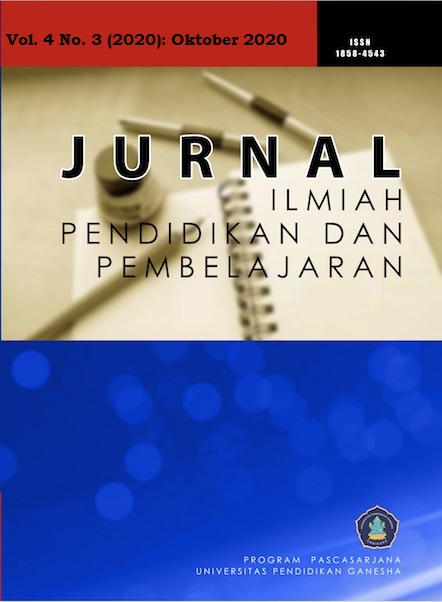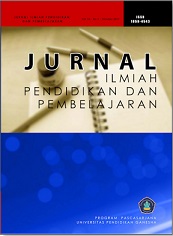Model Pembelajaran Flipped Classroom pada Mata Kuliah Algoritma dan Struktur Data
DOI:
https://doi.org/10.23887/jipp.v4i3.26928Keywords:
Model Pembelajaran Flipped Classroom, penelitian dan pengembangan, hasil validitas, praktikalitas dan efektifitas.Abstract
Penelitian ini dilatarbelakangi oleh keterbatasan inovasi dalam pembelajaran yang mengakibatkan siswa kurang aktif dalam melaksanakan pembelajaran sehingga proses pembelajaran bersifat monoton sehingga membuat hasil belajar siswa menjadi rendah. Tujuan dari penelitian ini adalah untuk menghasilkan model pembelajaran Flipped Classroom yang valid, praktis dan efektif. Penelitian ini merupakan penelitian pengembangan (Research and Development/ R&D). Desain penelitian ini menggunakan 4-D yang langkah-langkahnya terdiri dari mendefinisikan, merancang, mengembangkan dan menyebarluaskan. Jenis data yang digunakan adalah data primer yang diperoleh langsung dari sekolah, guru, pakar dan siswa. Hasil penelitian menunjukkan bahwa media yang dikembangkan adalah media yang valid dengan rata-rata validitas media 0,85% dan validitas materi sebesar 0,89%, dan praktis dengan nilai kepraktisan dari respons pendidik sebesar 93,00% dan tanggapan peserta didik 92,53%. Berdasarkan hal tersebut, dapat disimpulkan bahwa model pembelajaran yang dikembangkan bersifat valid, praktis, dan efektif dalam meningkatkan pemahaman peserta didik yang juga berimplikasi pada peningkatan hasil belajar peserta didik.
References
Alamri, M. M. (2019). Students' academic achievement performance and satisfaction in a flipped classroom in Saudi Arabia. International Journal of Technology Enhanced Learning, 11(1), 103-119. https://doi.org/10.1504/IJTEL.2019.096786
Amiroh, S. (2012). Kupas Tuntas Membangun E-Learning Dengan Learning Management System Moodle Ver. 2: Kupas Tuntas Membangun E-Learning Dengan Learning Management System Moodle Ver. 2. Genta Group Production.
Asfar, N., & Zainuddin, Z. (2015). Secondary students' perceptions of information, communication and technology (ICT) use in promoting self directed learning in Malaysia. The Online Journal of Distance Education and E-Learning, 3(4), 67-82. http://www.tojdel.net/journals/tojdel/volumes/tojdel-volume03-i04.pdf#page=74
Awidi, I. T., & Paynter, M. (2019). The impact of a flipped classroom approach on student learning experience. Computers & Education, 128, 269-283. https://doi.org/10.1016/j.compedu.2018.09.013
Bergmann, J., & Sams, A. (2012). Flip your classroom: Reach every student in every class every day. International society for technology in education.
Daryanto, D. (2013). Media pembelajaran peranannya sangat penting dalam mencapai tujuan pembelajaran. Gava Media..
Davies, R. S., Dean, D. L., & Ball, N. (2013). Flipping the classroom and instructional technology integration in a college-level information systems spreadsheet course. Educational Technology Research and Development, 61(4), 563-580. https://doi.org/10.1007/s11423-013-9305-6
Du, X., Zhang, M., Shelton, B. E., & Hung, J. L. (2019). Learning anytime, anywhere: a spatio-temporal analysis for online learning. Interactive Learning Environments, 1-15. https://doi.org/10.1080/10494820.2019.1633546
Enfield, J. (2013). Looking at the impact of the flipped classroom model of instruction on undergraduate multimedia students at CSUN. TechTrends, 57(6), 14-27. https://doi.org/10.1007/s11528-013-0698-1
Findlay-Thompson, S., & Mombourquette, P. (2014). Evaluation of a flipped classroom in an undergraduate business course. Business Education & Accreditation, 6(1), 63-71. https://papers.ssrn.com/sol3/papers.cfm?abstract_id=2331035
Fisher, D. (2009, April). The use of instructional time in the typical high school classroom. In The Educational Forum (Vol. 73, No. 2, pp. 168-176). Taylor & Francis Group. https://doi.org/10.1080/00131720902739650
Johnson, G. B. (2013). Student perceptions of the flipped classroom (Doctoral dissertation, University of British Columbia).
Joyce, B., & Weil, M. (2003). Model of Teaching (Fifth-Edition). Allyn & Bacon.
Kim, M. K., Kim, S. M., Khera, O., & Getman, J. (2014). The experience of three flipped classrooms in an urban university: an exploration of design principles. The Internet and Higher Education, 22, 37-50. https://doi.org/10.1016/j.iheduc.2014.04.003
Kong, S. C. (2014). Developing information literacy and critical thinking skills through domain knowledge learning in digital classrooms: An experience of practicing flipped classroom strategy. Computers & Education, 78, 160-173. https://doi.org/10.1016/j.compedu.2014.05.009
Love, B., Hodge, A., Grandgenett, N., & Swift, A. W. (2014). Student learning and perceptions in a flipped linear algebra course. International Journal of Mathematical Education in Science and Technology, 45(3), 317-324. https://doi.org/10.1080/0020739X.2013.822582
Raths, D. (2014). Nine video tips for a better flipped classroom. The Education Digest, 79(6), 15. https://search.proquest.com/openview/87c02524433eba786c1d1b2096c47f96/1.pdf?pq-origsite=gscholar&cbl=25066
Shyr, W. J., & Chen, C. H. (2018). Designing a technology‐enhanced flipped learning system to facilitate students' self‐regulation and performance. Journal of Computer assisted learning, 34(1), 53-62. https://doi.org/10.1111/jcal.12213
Sugiyono. (2012). Metode Penelitian Pendidikan (Pendekatan Kuantitatif, Kualitatif dan R&D. Alfabeta.
Velegol, S. B., Zappe, S. E., & Mahoney, E. M. I. L. Y. (2015). The Evolution of a Flipped Classroom: Evidence-Based Recommendations. Advances in Engineering Education, 4(3). https://eric.ed.gov/?id=EJ1076140
Zainuddin, Z., & Keumala, C. M. (2018). Blended learning method within Indonesian higher education institutions. Jurnal Pendidikan Humaniora, 6(2), 69-77. http://journal.um.ac.id/index.php/jph/article/view/10604
Zainuddin, Z., & Perera, C. J. (2018). Supporting students’ self-directed learning in the flipped classroom through the LMS TES BlendSpace. On the Horizon, 26(4). https://doi.org/10.1108/OTH-04-2017-0016
Zainuddin, Z., Habiburrahim, H., Muluk, S., & Keumala, C. M. (2019). How do students become self-directed learners in the EFL flipped-class pedagogy? A study in higher education. Indonesian Journal of Applied Linguistics, 8(3), 678-690. https://doi.org/10.17509/ijal.v8i3.15270
Zainuddin, Z., Haruna, H., Li, X., Zhang, Y., & Chu, S. K. W. (2019). A systematic review of flipped classroom empirical evidence from different fields: what are the gaps and future trends?. On the Horizon, 27(2). https://doi.org/10.1108/OTH-09-2018-0027
Zhou, G. Q., & Jiang, X. F. (2014). Theoretical research and instructional design of the flipped classroom. In Applied Mechanics and Materials (Vol. 543, pp. 4312-4315). Trans Tech Publications Ltd. https://www.scientific.net/AMM.543-547.4312
Downloads
Published
How to Cite
Issue
Section
License
Authors who publish with the Jurnal Ilmiah Pendidikan dan Pembelajaran (JIPP) agree to the following terms:
- Authors retain copyright and grant the journal the right of first publication with the work simultaneously licensed under a Creative Commons Attribution License (CC BY-SA 4.0) that allows others to share the work with an acknowledgment of the work's authorship and initial publication in this journal.
- Authors are able to enter into separate, additional contractual arrangements for the non-exclusive distribution of the journal's published version of the work (e.g., post it to an institutional repository or publish it in a book), with an acknowledgment of its initial publication in this journal.
- Authors are permitted and encouraged to post their work online (e.g., in institutional repositories or on their website) prior to and during the submission process, as it can lead to productive exchanges, as well as earlier and greater citation of published work. (See The Effect of Open Access)










